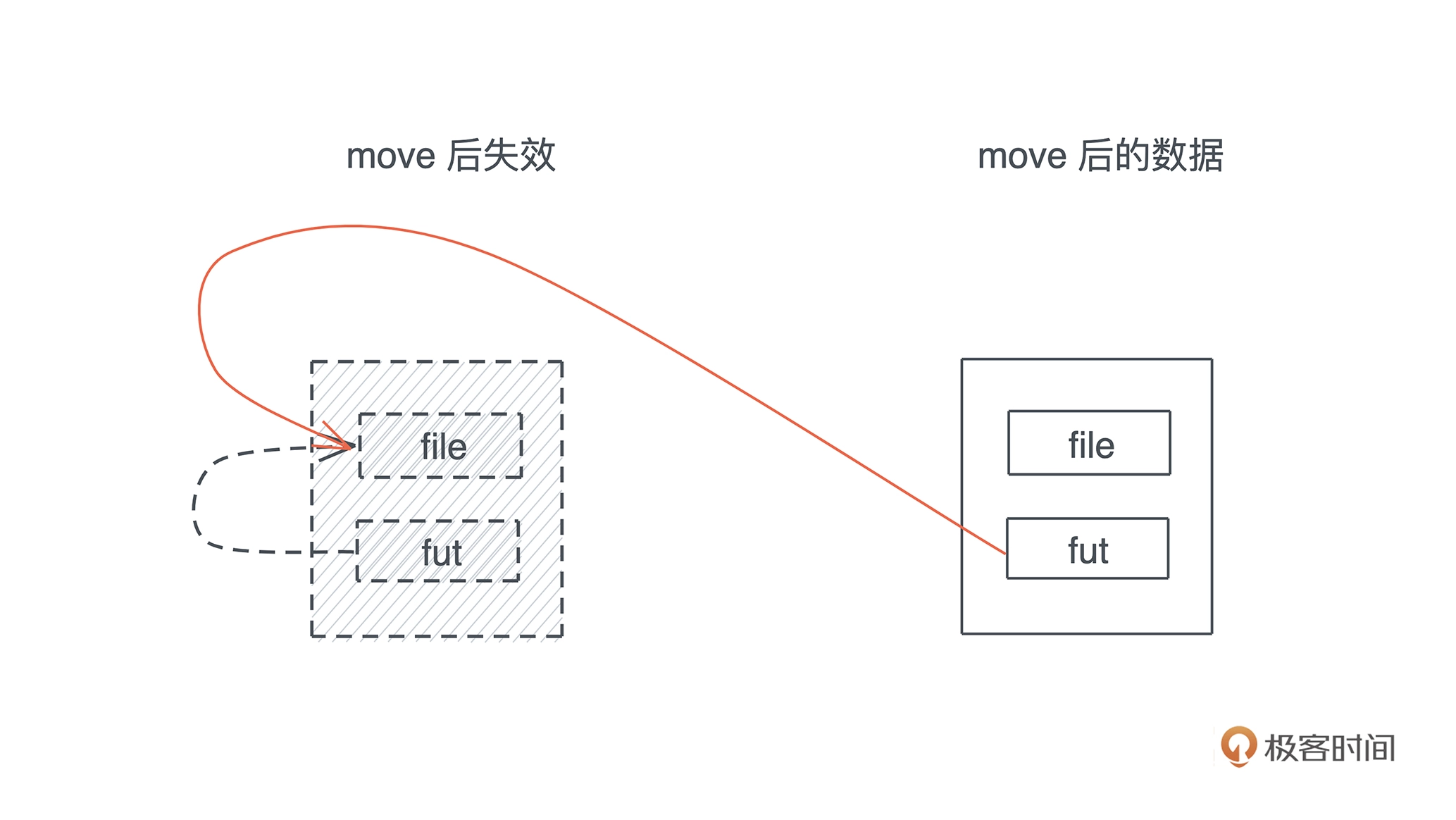Tower 是一个专注于对网络编程进行抽象的框架,最核心的抽象为 Service trait。Service::call 接受一个 request 进行处理,成功则返回 response,否则返回 error。
|
|
# Service trait 的定义
我们希望 Service 是异步编程风格,也就是 call 为 async 方法:
|
|
我们就可以在 Service::call 上 await:
|
|
然而当前 Rust 不支持 async trait 方法。
我们可以让 call 作为普通方法,返回一个实现了 Future 的类型:
|
|
还是不行,目前 Rust 也不支持在 Trait 中使用 impl Trait 做返回值,上一篇文章<impl Trait 的使用>分析过原因。
Tower 在定义 Service 时,使用了关联类型 type Future ,其实是将问题留给了 Service 的实现者,由用户选择 type Future 的实际类型:
|
|
# 实现自己的 Future 类型
我们在实现 Service 时,仍然需要为type Future 设置具体的类型。
既然没法让 call 直接返回 impl Future,一种方法是定义自己的 Future 类型,例如:
|
|
在实现 Service 时,关联类型 type Future 设置为我们手工实现的 Future:
|
|
然后就可以像正常的 Future 一样,使用 Service :
|
|
# 使用 async blocks
手工实现 Future 会比较麻烦,我们一般都是用 async fn/async blocks语法糖生成 Future,那么这时 Service::call 返回什么类型呢?
|
|
既然不能返回 impl Trait ,可以让 call 返回 trait object,用 trait object 统一返回值的类型。
|
|
这时候会报错,说 dyn Future 没有实现 Unpin:
|
|
编译错误提示的没有实现 Unpin trait 是什么意思?那要先从 Pin 说起。
# 一句话解释Pin
Pin 本质上解决的问题是保证 Pin<P<T>> 中的 T 不会被 move,除非 T 满足 T: Unpin。
# 什么是move
所有权转移的这个过程就是 move,例如:
|
|
s2 浅copy s1 的内容,同时 String 的所有权转移给了 s2。
通过std::mem::swap()方法交换了两个可变借用 &mut 的内容,也发生了move。
# 为什么要Pin
自引用结构体,move了以后会出问题。

所以需要 Pin,不能move。
# 怎么 Pin 住的
保证 T 不会被move,需要避免两种情况:
- 不能暴露 T ,否则赋值、方法调用等都会move
- 不能暴露 &mut T,开发者可以调用
std::mem::swap()或std::mem::replace()这类方法来 move 掉 T
Pin<P<T>>没有暴露T,而且没法让你获得 &mut T,所以就 Pin 住了T。但注意有个前提条件:T 没有实现 Unpin
# 谁没有实现 Unpin
Unpin 是一个auto trait,编译器默认会给所有类型实现 Unpin。唯独有几个例外,他们实现的是 !Unpin。
- PhantomPinned
|
|
- 如果你使用了 PhantomPinned,你的类型自动实现
!Unpin
|
|
- 编译器为
async fn生成的匿名结构体实现的是!Unpin
# async fn
async fn 是语法糖,在编译时,编译器使用Generator为 async fn 生成匿名结构体,这个结构体实现了 Future。
这个匿名结构体是自引用的。原因是,如果 async fn 内有多个 await,执行到 await 可能因为资源没准备好而让出 CPU 暂停执行,随后该 Future 可能被调度到其他线程接着执行。所以这个匿名结构体需要保存跨 await 的数据,形成了自引用结构。
由于为 async fn 生成的结构体是自引用的,所以这个结构体实现了 !Unpin,表示它不能被 move。
这也是为什么不能给Future::poll 直接传 &mut Self 的原因:生成的匿名结构体不能被move,而拿到 &mut Self就可以使用 swap 或 replace之类的方法进行move,这样不安全,所以必须使用 Pin<&mut Self>。
# Future 都是 !Unpin 的吗
不一定。
async fn 语法糖生成的实现了 Future 的匿名结构,内部包含自引用,它会明确实现 !Unpin,不能 move。
但如果你自己实现的 Future,内部没有自引用,它就不是 !Unpin,当然可以 move。
也就是说,Future 和 !Unpin 是两个 trait,虽然它们经常联系在一起,但并不是实现了 Future 的类型都必须同时实现 !Unpin,没有包含自引用的 Future当然可以安全的 move 了。
# 实现了 Unpin 的 Future
如果是可以 move 的 Future,也就是实现了 Unpin 的 Future,在调用 Future::poll 的时候,要求传入 Pin<&mut Self>,会不会有什么问题呢?
首先,如果 T:Unpin,那么 Pin<&mut T> 就完全等同于 &mut T。换句话说,Unpin 意味着这个类型可以被移动,即使是在 Pin 住的情况下,所以 Pin 对这样的类型没有影响。因为 Pin 是智能指针,它实现了 Deref/DerefMut,只要满足 T: Unpin,你就能拿到&mut T:
|
|
其次,为了用户方便,FutureExt 提供了 poll_unpin,让你直接在 Unpin 的 Future 上 poll:
|
|
所以,如果你的 Future 是 Unpin,那么即使Future::poll 要求传入的是 Pin<&mut Self>,对你也没有任何影响。
# Box<dyn Futrue<>> 的问题
回到上面的问题,我们想让 Service::call 返回 trait object,也就是 Box<dyn Futrue<>>,会编译不过,为什么呢?
因为标准库为 Box 实现了 Future,但要求 Box 包装的 Future 必须同时实现了 Unpin :
|
|
前面已经讲过,async 解语法糖生成的 Future 没有实现 Unpin,所以Box::new(async{...}) 不满足类型约束,它没有实现 Future,不能在它上面await。
# Pin 实现了 Future
前面讲过,在 Future 上 poll 的时候,不能直接传入&mut Self,而需要传入 Pin<&mut Self>,需要这样调用 Future::poll(Pin::new(&mut future), ctx)。如果 Pin 实现了 Future ,我们就可以直接这样 poll 了: Pin::new(&mut future).poll(ctx)。
标准库也确实为 Pin 实现了 Future:
|
|
我们来看对 P 的约束,P 可解引用为 Future,也就是说,P是 Future 的引用 &mut future,或者是智能指针 Box<dyn Future> 都可以满足约束。因为 Pin<Box<dyn Future<>>> 实现了 Future,我们可以用它作为 Service::call 返回值类型。
Box 提供了 pin 方法,让用户构建 Pin<Box<T>>:
|
|
使用 Box::pin,RequestHanlder 可以这么修改:
|
|
这回终于可以了。事实上,在异步场景下,我们经常会看到使用 Box::pin 去包装 async block。
# Pin<Box<dyn Future<>>>
Pin<Box<dyn Future<>>> 除了实现了Future,也实现了 Unpin。
因为 Pin 实现了 Unpin,只要 P 是 Unpin 的:
|
|
而 Box 正好是 Unpin 的:
|
|
因此 Pin<Box<T>>是 Unpin 的。可以这么理解,Pin 钉住了 T,但 Pin 本身是 Unpin的,可以安全的 move。
很多异步方法需要你的 Future 同时实现了 Unpin ,例如tokio::select!(),而 async fn 返回的 Future 显然不满足 Unpin,这个时候仍然可以用 Box::pin把 Future pin 住,得到的Pin<Box<dyn Future<...>>> 同时实现了 Future 和 Unpin,满足你的要求。
简单总结,在异步编程场景,我们经常会用Box::pin 包装 async block,获得同时实现了 Future 和 Unpin 的Pin<Box<dyn Future<>>>。